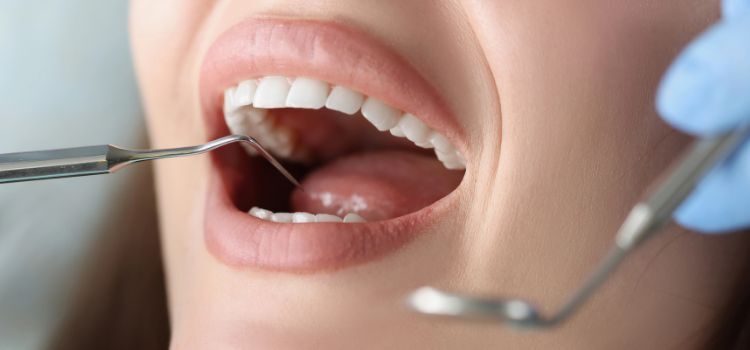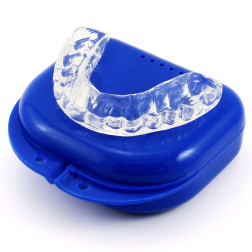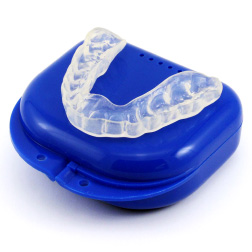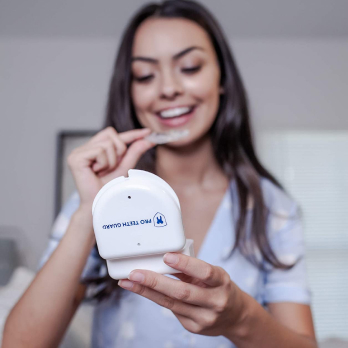Losing Enamel on Front Teeth
15th Nov 2025

If your front teeth look worn, thin, or see-through, you may be losing enamel. Enamel is the hard outer layer that protects your teeth. Once it wears down, it won’t grow back.
This can happen slowly over time from things like acidic drinks, brushing too hard, or grinding your teeth. The good news is, there are ways to treat and protect your teeth.
Here’s what you need to know about enamel, why it matters, and how to protect it.
Signs You May Be Losing Enamel on Front Teeth

A study found that enamel loss often happens slowly and is caused by acid, brushing too hard, or grinding, making changes in your teeth easy to miss at first.
You might be losing enamel if you notice:
- Teeth look see-through at the edges
- Increased sensitivity to hot, cold, or sweet food
- Teeth feel rough or have sharp edges
- Yellow or dull color, as the inner layer (dentin) starts to show
- Small chips or cracks, especially on the front teeth
Note: These changes can happen slowly, so it’s good to check your teeth in the mirror now and then or ask your dentist if something feels off.
Common Causes of Enamel Loss on Front Teeth
Acidic Foods and Drinks
Sodas, citrus fruits, vinegar, and even some juices are highly acidic. Over time, they can wear away the enamel on your front teeth.
Acid Reflux (GERD)
If you have frequent heartburn or reflux, stomach acid can reach your mouth. This acid is strong enough to erode enamel, especially on the front teeth.
Teeth Grinding (Bruxism)
Grinding or clenching your teeth, often while sleeping, puts pressure on enamel. Over time, it can lead to thinning and damage, especially around the edges.
Brushing Too Hard
Brushing with too much force or using a hard-bristled toothbrush can wear down enamel. It’s best to brush gently with a soft-bristled brush.
Dry Mouth
Saliva helps protect your teeth by washing away acids and bacteria. If your mouth feels dry often, your enamel might be at higher risk.
Related Articles:
Can Lost Enamel Be Restored?
According to Colgate, enamel doesn't grow back once it’s gone. It’s not like skin or bone. It can't repair itself naturally.
But don’t worry. While the enamel can’t return, there are treatments that can protect your teeth and improve how they look and feel.
Note: Dentists can use bonding or veneers to rebuild worn spots. Special toothpaste and remineralizing products can also help strengthen the enamel you still have and make your teeth less sensitive.
Treatment Options for Enamel Loss
Fluoride Toothpaste
Using fluoride toothpaste helps strengthen the enamel you still have. It doesn’t replace lost enamel, but it can protect your teeth from further damage.
Remineralizing Products
Some products contain calcium and phosphate, which help rebuild weak areas on the tooth surface. These can reduce sensitivity and protect against decay.
Composite Bonding
If your front teeth are chipped or worn, a dentist can apply tooth-colored resin to cover the damaged areas. It blends in with your natural teeth and helps protect them.
Veneers or Crowns
For more severe enamel loss, veneers or crowns may be recommended. These cover the front of the teeth and restore their look and strength.
Night Guard for Teeth Grinding
If grinding is wearing down your enamel, wearing a custom-fit night guard while you sleep can prevent further damage.
Related Articles:
- Guide to Choosing the Right Night Guard
- Wearing a Night Guard: Pros and Cons
- How Does A Night Guard Work?

- Most Popular
- Hard Outside, Soft Inside
- 2MM Thick
- Moderate / Heavy

- Most Durable
- Hard Materials
- 1.5MM Thick
- Heavy / Severe

- For Day Time Use
- Thin, Barely Visible
- 1MM Thick
- Light / Moderate

- For Clenching
- Flexible & Soft
- 1.5MM Thick
- Light / Moderate
How to Protect Your Front Teeth from More Damage

Use a Straw for Acidic Drinks
According to studies, acidic beverages can increase the risk of tooth erosion. Drinking them through a straw may help limit contact with your front teeth, reducing potential enamel damage.
Rinse After Eating or Drinking
Rinse your mouth with water after meals or acidic drinks. This helps wash away acids before they can harm your enamel.
Wait Before Brushing
Don’t brush right after eating acidic foods. Wait at least 30 minutes so your enamel isn’t softened when you brush.
Brush Gently
Use a soft-bristled toothbrush and avoid brushing too hard. Gentle brushing is enough to clean your teeth without wearing them down.
Wear a Night Guard
If you grind your teeth at night, a custom-fit night guard can help prevent further enamel loss.
Keep Up with Dental Visits
Regular checkups can catch enamel issues early and help you stay on top of prevention and treatment.
What Is Enamel and Why Does It Matter?
Enamel is the thin, hard layer that covers the outside of your teeth. It protects the softer parts underneath from damage, decay, and sensitivity.
According to an article on the microstructure of enamel, it’s made up of about 96% inorganic minerals, mostly hydroxyapatite, and around 4% organic proteins and water. This high mineral content is what makes enamel the hardest substance in the human body.
Even though it’s the hardest substance in the body, enamel can wear down from everyday habits. Once it’s gone, it doesn’t grow back.
Losing enamel makes teeth more sensitive, more likely to chip, and more at risk for cavities. It also affects how your teeth look, especially the front ones, which are most visible when you smile or talk.
Did you know? Enamel hypoplasia happens when your teeth don’t form enough enamel. Unlike erosion, which wears enamel away over time, hypoplasia means the enamel was never fully there to begin with.
When to See a Dentist
It’s a good idea to see a dentist if:
- Your front teeth are becoming see-through or rough
- You feel sharp or sudden sensitivity
- You notice chipping, cracks, or yellowing
- Your teeth look different and you’re not sure why
Note: A dentist can check how much enamel is lost, find the cause, and recommend the right treatment. The earlier you get help, the easier it is to protect your teeth and prevent more damage.
Frequently Asked Questions
1. What Does Enamel Loss Look Like on Front Teeth?
You might see thin, see-through edges, rough surfaces, or yellowing. Your teeth may also feel more sensitive to hot, cold, or sweet foods.
2. Do Night Guards Really Help Protect Enamel?
Yes. A custom night guard can protect your teeth from grinding damage, which is a major cause of enamel wear, especially on front teeth. Read more on: Teeth Grinding Damage
3. What Happens If You Get Too Much Fluoride?
Too much fluoride, especially in kids, can cause white spots or marks on the teeth. This is called enamel fluorosis. It usually happens from swallowing toothpaste or taking too many supplements. Most cases are mild and not harmful.
Final Thoughts
Losing enamel on your front teeth can be worrying, but you're not alone, and it’s something that can be managed with the right care.
While enamel doesn’t grow back, there are simple ways to protect your teeth, reduce sensitivity, and restore your smile. From daily habits to dental treatments, small changes can make a big difference.
If teeth grinding is part of the problem, wearing a custom-fit night guard can help stop further damage while you sleep.
References:
- Boyde, A. (1986). Microstructure of enamel. In Dental enamel: Proceedings of the Ciba Foundation Symposium (Vol. 205, pp. 18–31). Wiley. https://doi.org/10.1002/9780470515303.ch3
- Cleveland Clinic. (n.d.). Enamel hypoplasia. Cleveland Clinic Health Library. Retrieved June 17, 2025, from https://my.clevelandclinic.org/health/diseases/enamel‑hypoplasia
- Colgate. (n.d.). Can tooth enamel be restored? Colgate. Retrieved June 17, 2025, from https://www.colgate.com/en-us/oral-health/adult-oral-care/can-tooth-enamel-be-restored
- West, N. X., & Joiner, A. (2014). Enamel mineral loss. Journal of Dentistry, 42 (Supplement 1), S2–S11. https://doi.org/10.1016/S0300-5712(14)50002-4
- Colgate. (n.d.). The best remineralizing toothpaste for enamel. Colgate. Retrieved June 17, 2025, from https://www.colgate.com/en-ph/oral-health/brushing-and-flossing/best-remineralizing-toothpaste-for-enamel
- Ehlen, L. A., Marshall, T. A., Qian, F., Wefel, J. S., & Warren, J. J. (2008). Acidic beverages increase the risk of in vitro tooth erosion. Nutrition Research, 28(5), 299–303. https://doi.org/10.1016/j.nutres.2008.03.001

- Most Popular
- Hard Outside, Soft Inside
- 2MM Thick
- Moderate / Heavy

- Most Durable
- Hard Materials
- 1.5MM Thick
- Heavy / Severe

- For Day Time Use
- Thin, Barely Visible
- 1MM Thick
- Light / Moderate

- For Clenching
- Flexible & Soft
- 1.5MM Thick
- Light / Moderate
